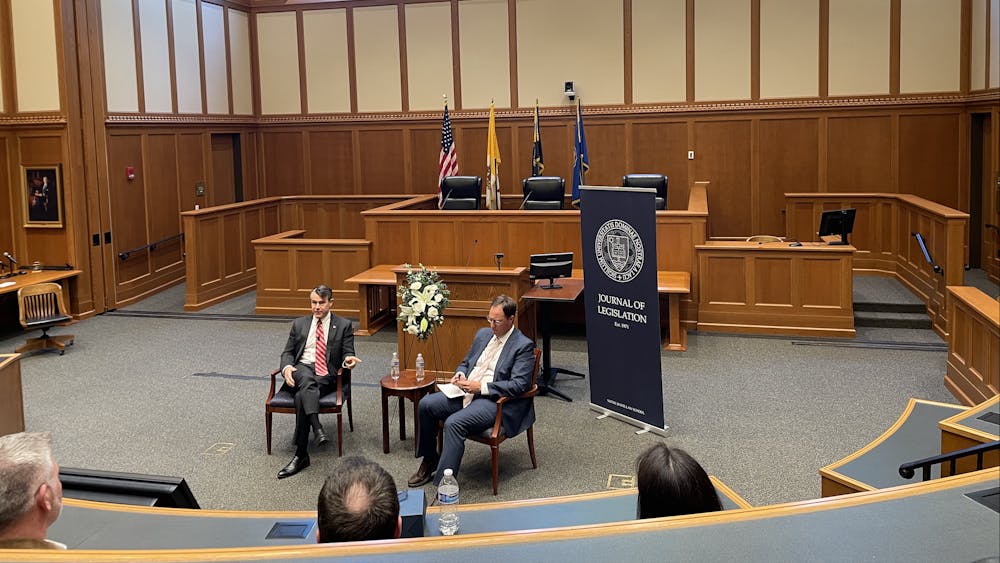Journalism's current challenge isn't saving print newspapers. The challenge is maintaining high standards in emerging new media forms, visiting journalists said Monday.
Jill Abramson, managing editor for news at The New York Times, and Executive Editor for The Pittsburgh Post-Gazette David Shribman spoke about the future of journalism in a discussion sponsored by the Gallivan Program in Journalism, Ethics and Democracy in McKenna Hall.

"I hope the printed product lasts a long time. I think it has virtue and value," Shribman said. "But we can do so much more in journalism now. There's such a richer atmosphere and so many opportunities."
Abramson said the Internet has changed the business. Working as a journalist in the late 1980s and early 90s, she said newspapers were "fat and happy."
"I don't think we quite appreciated in real time the great tumult and change the profession was about to go through," she said. "It has not been necessarily all negative, but certainly more challenging."
The New York Times online reaches a new base of readers and captures about 20 million unique readers every month.
"The opportunity to reach this much larger audience is quite thrilling, and in terms of quality journalism, it provides opportunities to tell stories in completely different and exciting ways," Abramson said.
But the problem facing many newspapers is that quality reporting is expensive, Abramson told The Observer in an interview.

"I think the thread is just finding a secure business model that can sustain the work to produce quality journalism. It can be very expensive," she said. "The Times has an investigative journalism unit in which reporters spend weeks and months and occasionally more than year getting an important story."
Abramson said The New York Times spends about $4 million maintaining secure bureaus in Iraq and Afghanistan — a price many papers can't afford to pay.
Shribman said new, Web-based media offers opportunities to tell stories in a different way. The challenge is paying for it.
He said The Post-Gazette has been experimenting with different business models to pay for the paper's production, namely offering a portion of their Web site for a price. The content that has always been accessible for free still is, he said, but users can subscribe to additional material.
"There isn't a huge demand for people to pay for content that has been previously free," Shribman said of charging for articles on the Web. "But there are people willing to pay to support us and receive premium content."
This model has seen some "steady growth," Shribman told The Observer.
But while online journalism has changed the business, both journalist said the standards remain high.
Abramson said one of the most difficult ethical decisions she has made at The Times involved publishing a story about a secret governmental counter-terrorism program. She said the Bush administration asked the editors to exclude the story from news reports because of security reasons.
"We took this very seriously and anguished over it for a quite a long period of time," she told The Observer. "As reporters found out more about the program, it was clear it was legally extremely dubious so we felt at a certain point if a secret illegal program was being waged in America, people had the right to know about it."
Shribman said the Post-Gazette makes decisions about whether to print certain stories or names on a case by case basis, carefully weighing newsworthiness and ethics.
"You sometimes are under enormous professional pressure to print something and under different but just as enormous personal pressure as a human being," he said.
Shribman and Abramson said ethical standards and reporting skills apply in all aspects of journalism.
Abramson said years ago, the debate about the future of journalism involved pitting blogs against mainstream media. But she said debate is mostly put to rest, as blogs fill a different niche in the media.
She said The New York Times has blogs discussing different, specific interests.
"Blogs could be like the cartoons and columns of this era," Shribman said.
And Abramson said even newer media forms like Twitter have played a role in news reporting.
"When the plane went into the Hudson River, the first reports came via Twitter," she told The Observer. "There is a genuine news value to Twitter."
Abramson said journalists have to be ready to adapt to the changing landscape of journalism.
"I've come to the conclusion that there's no genius out there with the answer to the business model problem right now, and how to sustain quality journalism," she said. "We can't hide in a foxhole and say we aren't going to get our hands dirty with this question."
While the business of journalism is changing though, Shribman said the basic skills remain the same.
"It's a lifetime of learning, a lifetime of being curious and a lifetime of satisfying that curiosity," he said.












